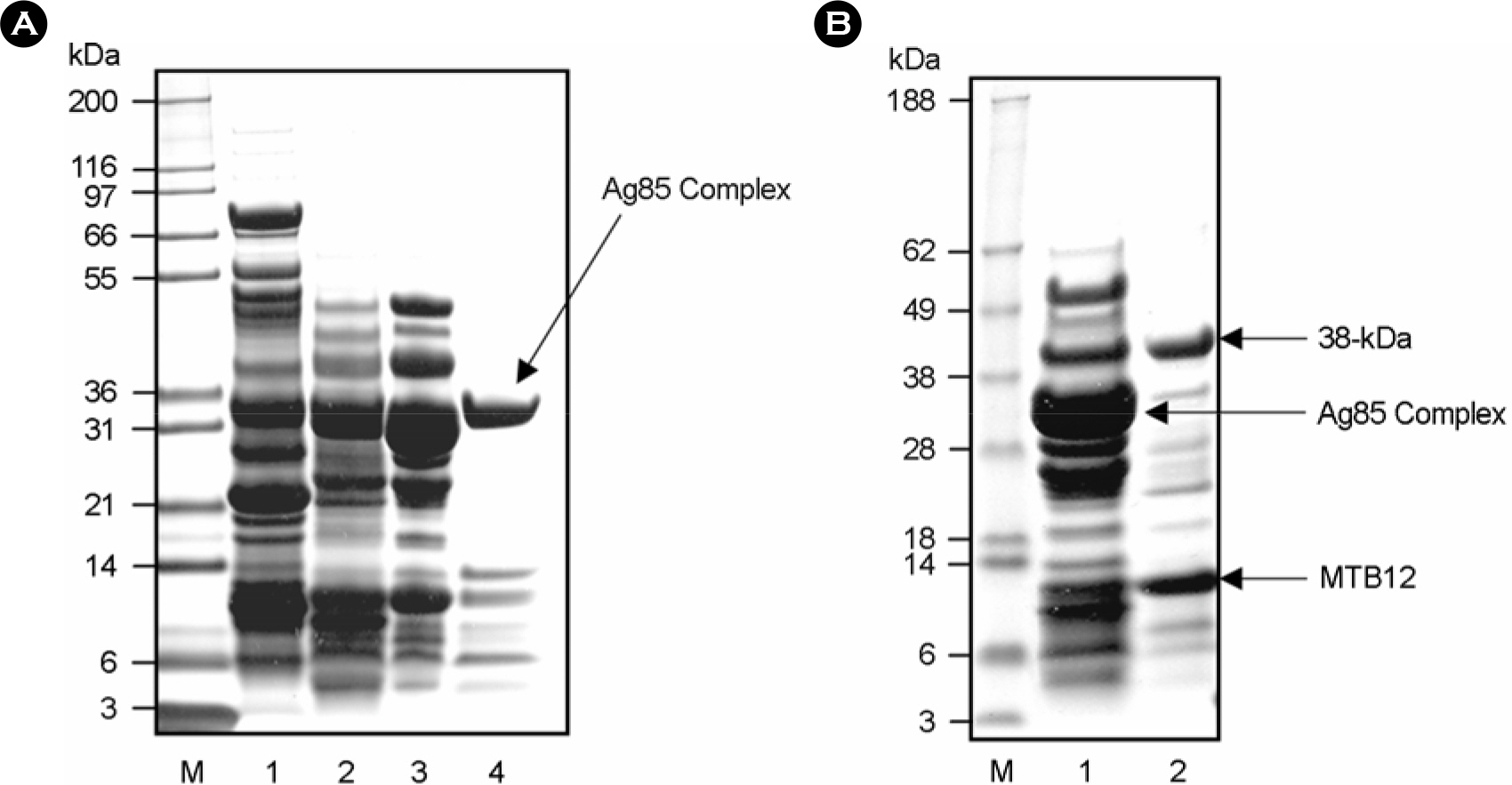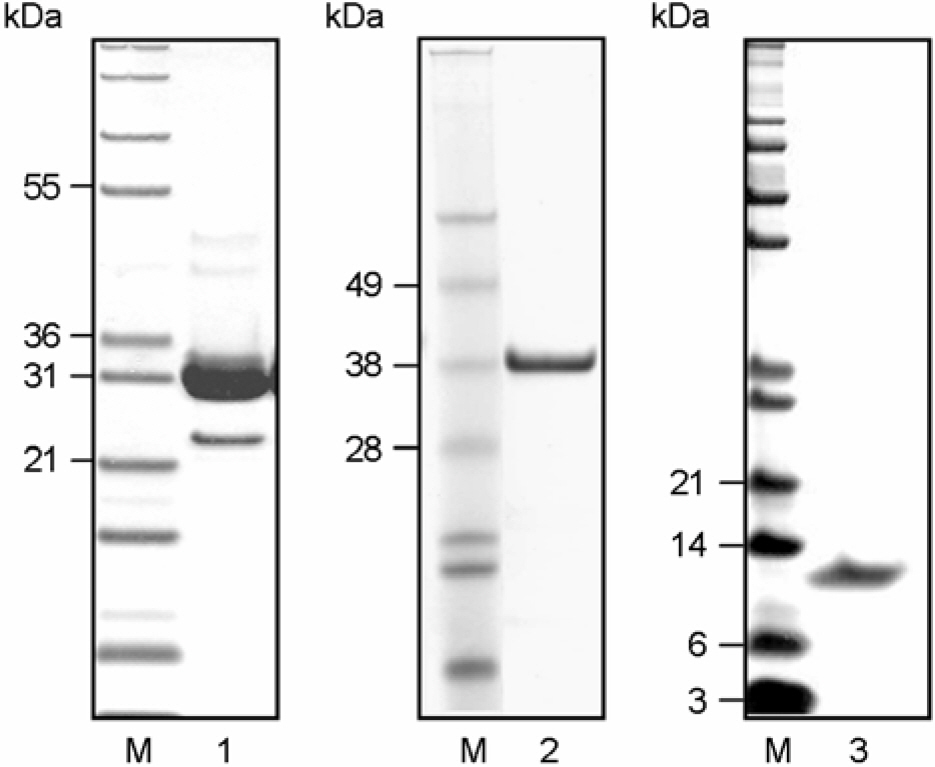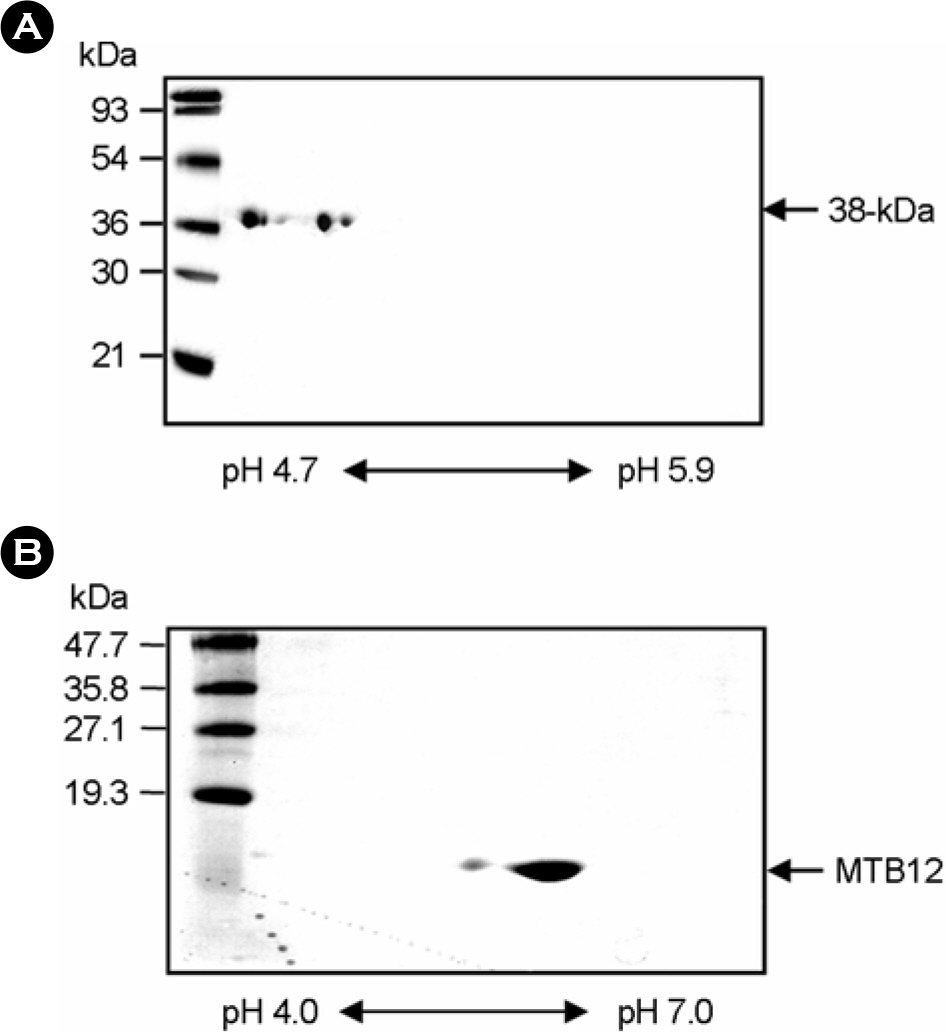J Bacteriol Virol.
2006 Dec;36(4):211-220. 10.4167/jbv.2006.36.4.211.
Purification of Native Ag85 Complex, 38-kDa and MTB12 Protein Antigens from the Culture Filtrate of Mycobacterium tuberculosis
- Affiliations
-
- 1Department of Microbiology, College of Medicine, Konyang University, Daejeon, Korea. thpaik@konyang.ac.kr
- 2Department of Microbiology, College of Medicine, Chungnam National University, Daejeon, Korea.
- KMID: 2055029
- DOI: http://doi.org/10.4167/jbv.2006.36.4.211
Abstract
- The purification of immunodominant native protein antigens from the culture filtrates of Mycobacterium tuberculosis is needed for the development of new vaccines and immunodiagnostic reagents against tuberculosis. In the present study, we conducted large scale purification of well-known secreted antigens, Ag85 complex, 38-kDa, and MTB12, from the culture filtrate proteins (CFPs) prepared from M. tuberculosis H37Rv grown as a surface pellicle on synthetic Sauton medium. The protein and antigen concentrations of culture filtrates were sufficiently increased after 6 week of culture. The MTB12 antigen was detected as early as 1 week of culture, and Ag85 complex and 38-kDa antigen were detected after 2 and 3 week of culture, respectively, by immunodiffusion with specific antiserum against 100-fold concentrated culture filtrates. For large-scale purification, the six-week-culture filtrates of M. tuberculosis H37Rv diluted 2.5-fold with 20 mM Tris-HCl, (P)H 8.3 were subjected to anion-exchange chromatography. The CFPs were eluted with 100 mM NaCl-20 mM Tris-HCl, pH 8.3 and concentrated by ultrafiltration. The concentrated CFPs were fractionated with ammonium sulfate, and followed by hydrophobic interaction chromatography and anion-exchange chromatography (FPLC). Eventually, 10 mg of Ag85 complex, 0.56 mg of 38-kDa, and 1.81 mg of MTB12 antigens were purified from 1 liter of the six-week-culture filtrates of M. tuberculosis H37Rv which contained 307.81 mg of protein of culture filtrate.
MeSH Terms
Figure
Reference
-
References
1). Andersen P, Askgaard D, Ljungqvist L, Bentzon MW, Heron I. T-cell proliferative response to antigens secreted by Mycobacterium tuberculosis. Infect Immun. 59:1558–1563. 1991.2). Andersen P. The T cell response to secreted antigens of Mycobacterium tuberculosis. Immunobiology. 191:537–547. 1994.3). Andersen AB, Hansen EB. Structure and mapping of anti-genic domains of protein antigen b, a 38,000-molecular-weight protein of Mycobacterium tuberculosis. Infect Immun. 57:2481–2418. 1989.4). Appelberg R. Protective role of interferon gamma, tumor necrosis factor alpha and interleukin-6 in Mycobacterium tuberculosis and M. avium infections. Immunobiology. 191:520–525. 1994.5). Barnes PF, Mehra V, Rivoire B, Fong SJ, Brennan PJ, Voegtline MS, Minden P, Houghten RA, Bloom BR, Modlin RL. Immunoreactivity of a 10-kDa antigen of Mycobacterium tuberculosis. J Immunol. 148:1835–1840. 1992.6). Boesen H, Jensen BN, Wilcke T, Andersen P. Human T-cell responses to secreted antigen fractions of Mycobacterium tuberculosis. Infect Immun. 63:1491–1497. 1995.7). Cardoso FL, Antas PR, Milagres AS, Geluk A, Franken KL, Oliveira EB, Teixeira HC, Nogueira SA, Sarno EN, Klatser P, Ottenhoff TH, Sampaio EP. T-cell responses to the Mycobacterium tuberculosis-specific antigen ESAT-6 in Brazilian tuberculosis patients. Infect Immun. 70:6707–6714. 2002.8). Chang Z, Choudhary A, Lathigra R, Quiocho FA. The immunodominant 38-kDa lipoprotein antigen of Mycobacterium tuberculosis is a phosphate-binding protein. J Biol Chem. 269:1956–1958. 1994.9). Colditz GA, Brewer TF, Berkey CS, Wilson ME, Burdick E, Fineberg HV, Mosteller F. Efficacy of BCG vaccine in the prevention of tuberculosis. Meta-analysis of the published literature. JAMA. 271:698–702. 1994.10). Daniel TM, Janicki BW. Mycobacterial antigens: a review of their isolation, chemistry, and immunological properties. Microbiol Rev. 42:84–113. 1978.
Article11). Davidow A, Kanaujia GV, Shi L, Kaviar J, Guo X, Sung N, Kaplan G, Menzies D, Gennaro ML. Antibody profiles characteristic of Mycobacterium tuberculosis infection state. Infect Immun. 73:6846–6851. 2005.12). Dye C, Scheele S, Dolin P, Pathania V, Raviglione MC. Consensus statement. Global burden of tuberculosis: estimated incidence, prevalence, and mortality by country. WHO Global Surveillance and Monitoring Project. JAMA. 282:677–686. 1999.13). Espinal MA. The global situation of MDR-TB. Tuberculosis (Edinb). 83:44–51. 2003.
Article14). Flesch IE, Kaufmann SH. Role of cytokines in tuberculosis. Immunobiology. 189:316–339. 1993.
Article15). Flynn JL, Chan J. Immunology of tuberculosis. Annu Rev Immunol. 19:93–129. 2001.
Article16). Fonseca DP, Benaissa-Trouw B, van Engelen M, Kraaijeveld CA, Snippe H, Verheul AF. Induction of cell-mediated immunity against Mycobacterium tuberculosis using DNA vaccines encoding cytotoxic and helper T-cell epitopes of the 38-kilodalton protein. Infect Immun. 69:4839–4845. 2001.17). Giulian GG, Moss RL, Greaser M. Analytical isoelectric focusing using a high-voltage vertical slab polyacrylamide gel system. Anal Biochem. 142:421–436. 1984.
Article18). Haga S, Yamaguchi R, Nagai S, Matsuo K, Yamazaki A, Nakamura RM. Delayed-type hypersensitivity to a recombinant mycobacterial antigen, MPB64, in guinea pigs sensitized to Mycobacterium tuberculosis or Mycobacterium bovis BCG. J Leukoc Biol. 57:221–225. 1995.19). Harth G, Lee BY, Wang J, Clemens DL, Horwitz MA. Novel insights into the genetics, biochemistry, and immuno-cytochemistry of the 30-kilodalton major extracellular protein of Mycobacterium tuberculosis. Infect Immun. 64:3038–3047. 1996.20). Horwitz MA, Lee BW, Dillon BJ, Harth G. Protective immunity against tuberculosis induced by vaccination with major extracellular proteins of Mycobacterium tuberculosis. Proc Natl Acad Sci U S A. 92:1530–1534. 1995.21). Kaufmann SH. Is the development of a new tuberculosis vaccine possible? Nat Med. 6:955–960. 2000.
Article22). Lee BY, Horwitz MA. T-cell epitope mapping of the three most abundant extracellular proteins of Mycobacterium tuberculosis in outbred guinea pigs. Infect Immun. 67:2665–2670. 1999.23). Lee JS, Son JW, Jung SB, Kwon YM, Yang CS, Oh JH, Song CH, Kim HJ, Park JK, Paik TH, Jo EK. Ex Vivo Responses for Interferon-gamma and Proinflammatory Cytokine Secretion to Low-Molecular-Weight Antigen MTB12 of Mycobacterium tuberculosis during Human Tuberculosis. Scand J Immunol. 64:145–154. 2006.24). Lim JH, Park JK, Jo EK, Song CH, Min D, Song YJ, Kim HJ. Purification and immunoreactivity of three components from the 30/32-kilodalton antigen 85 complex in Mycobacterium tuberculosis. Infect Immun. 67:6187–6190. 1999.25). Mehra V, Bloom BR, Bajardi AC, Grisso CL, Sieling PA, Alland D, Convit J, Fan XD, Hunter SW, Brennan PJ, et al. A major T cell antigen of Mycobacterium leprae is a 10-kD heat-shock cognate protein. J Exp Med. 175:275–284. 1992.26). Olsen AW, Williams A, Okkels LM, Hatch G, Andersen P. Protective effect of a tuberculosis subunit vaccine based on a fusion of antigen 85B and ESAT-6 in the aerosol guinea pig model. Infect Immun. 72:6148–6150. 2004.
Article27). Pehler K, Brasky KM, Butler TM, Attanasio R. Mycobacterium tuberculosis-secreted protein antigens: immunogenicity in baboons. J Clin Immunol. 20:306–316. 2000.28). Rosenkrands I, Weldingh K, Ravn P, Brandt L, Hojrup P, Rasmussen PB, Coates AR, Singh M, Mascagni P, Andersen P. Differential T-cell recognition of native and recombinant Mycobacterium tuberculosis GroES. Infect Immun. 67:5552–5558. 1999.29). Samanich KM, Keen MA, Vissa VD, Harder JD, Spencer JS, Belisle JT, Zolla-Pazner S, Laal S. Serodiagnostic potential of culture filtrate antigens of Mycobacterium tuberculosis. Clin Diagn Lab Immunol. 7:662–668. 2000.30). Schluger NW, Rom WN. The host immune response to tuberculosis. Am J Respir Crit Care Med. 157:679–691. 1998.
Article31). Silveira H, Ordway D, Dockrell H, Jackson M, Ventura F. Cell-mediated immune responses to mycobacterial antigens in patients with pulmonary tuberculosis and HIV infection. Clin Exp Immunol. 110:26–34. 1997.
Article32). Skjot RL, Oettinger T, Rosenkrands I, Ravn P, Brock I, Jacobsen S, Andersen P. Comparative evaluation of low-molecular-mass proteins from Mycobacterium tuberculosis identifies members of the ESAT-6 family as immunodominant T-cell antigens. Infect Immun. 68:214–220. 2000.33). Stenger S, Modlin RL. T cell mediated immunity to Mycobacterium tuberculosis. Curr Opin Microbiol. 2:89–93. 1999.34). Triccas JA, Roche PW, Winter N, Feng CG, Butlin CR, Britton WJ. A 35-kilodalton protein is a major target of the human immune response to Mycobacterium leprae. Infect Immun. 64:5171–5177. 1996.35). Webb JR, Vedvick TS, Alderson MR, Guderian JA, Jen SS, Ovendale PJ, Johnson SM, Reed SG, Skeiky YA. Molecular cloning, expression, and immunogenicity of MTB-12, a novel low-molecular-weight antigen secreted by Mycobacterium tuberculosis. Infect Immun. 66:4208–4214. 1998.36). Weinrich Olsen A, van Pinxteren LA, Meng Okkels L, Birk Rasmussen P, Andersen P. Protection of mice with a tuberculosis subunit vaccine based on a fusion protein of antigen 85b and esat-6. Infect Immun. 69:2773–2778. 2001.
Article
- Full Text Links
- Actions
-
Cited
- CITED
-
- Close
- Share
- Similar articles
-
- Purification and Partial Characterization of the 38 kDa Glycolipoprotein Antigen from the Culture Filtrate of Mycobacterium tuberculosis H37Rv
- Expression of the 38 kDa Protein of Mycobacterium tuberculosis in M . bovis BCG and Use in the Serodiagnosis of Tuberculosis
- Purification of 30-kDa and 32 kDa protein antigens from mycobacterium tuberculosis and activation of human monocytes by lymphokines
- Diagnostic Significance of the Serologic Test Using Antigen of Mycobacterium Tuberculosis for Antibody Detection by ELISA
- Purification and immunochemical charaterization of alpha-antigen from the culture filtrate of mycobacterium tuberculosis





